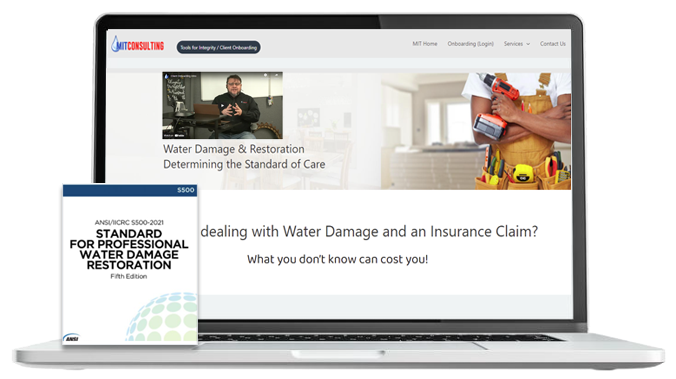
Discover how you can benefit from learning what's expected during the restoration process.
Do you know the roles and responsibilities for the Carrier, Contractor and You? Take control and with these tools and anticipate the road blocks before they happen.


Create New Client Account to Proceed
You must have an account to start using our onboarding system. It only takes a few minutes. You’ll need your insurance policy and a few more pieces of information.
Welcome to Onboarding - Education for Insureds

Getting Everyone on the Same Page at the Start of the Project
This program can help clients learn more about water damage and the restoration process. Many clients don’t realize they may need to make important decisions during the process. By learning a few of the industry IICRC Standards and Federal and/or State Regulations, you can be better equipped to make informed decisions on how you want your home restored to pre-loss condition. These tools are designed to help to promote transparency, benefitting all parties, insured, contractor and carrier. Making sure everyone knows what is expected can make the entire process much smoother.
MIT Onboarding Forms
Please fill out the forms below listed. Let us know if you have ANY questions.
Three Important Directives Before You Get Started
The following 3 directives should be requested from any insurance company that is handling your claim.
Below are the sections you will see on your form.
If you need to change or add information, you can modify the form through your dashboard after submission.
Standard of Care (Step 1)
Learn what your Insurance Company SHOULD allow your Contractor to Do
Why it’s important:
Taking the time to learn more about the IICRC Standards (industry guidelines for water damage restoration), you will learn what options you have in determining the Standard of Care for your project.
Site Survey & Property History (Step 2)
Tell us how you want us to preserve your property
Why it’s important:
Staying in compliance with local, state and federal regulations while ensuring your insurance company’s right to inspect requires both an immediate response and, to some degree limited work being performed until all the i’s can be dotted and t’s crossed.
How we maintain the environment during those investigations is often challenged by insurance companies. We think you should understand what we must do and will help you identify the conditions your contractor should be maintaining upfront so we can eliminate disagreements at the end.
Stabilization Plan (Step 3)
Tell us about your structure and and the other people that are in your structure (so that we can protect you).
Why it’s important:
Telling us when it was built can help to determine what materials were used during the construction. Also by providing information on the occupants may help us to determine if anyone has unique needs.
Hazards Sampling (Step 4)
Tell us about your building (so we can protect you and your structure)
Why it’s important:
There are things we must know to keep you and our crews safe. Telling us everything you know about your house, helps us do that.
Contractor Forms
Standard of Care
Why it’s important:
- Learn what your Insurance Company SHOULD allow your Contractor to Do
Taking the time to learn more about the IICRC Standards (industry guidelines for water damage restoration), you will learn what options you have in determining the Standard of Care for your project.
Directions: In a hurry? You can fill out the STANDARD of CARE “Summary” now, then return later and fill out the “Detailed” version. Or, if you have time please skip the “Summary” and go directly to the more comprehensive “Detailed” version.
Stabilization Plan
Why it’s important:
- Tell us how you want us to preserve your property
Staying in compliance with local, state and federal regulations while ensuring your insurance company’s right to inspect requires both an immediate response and, to some degree limited work being performed until all the i’s can be dotted and t’s crossed.
How we maintain the environment during those investigations is often challenged by insurance companies. We think you should understand what we must do and will help you identify the conditions your contractor should be maintaining upfront so we can eliminate disagreements at the end.
Site Survey & Property History
Why it’s important:
- Tell us about your structure and and the other people that are in your structure (so that we can protect you).
Not one size fits all. Just like every house is unique. Telling us when it was built can help to determine what materials were used during the construction.
Providing information on the the occupants may help us in determining if anyone has unique needs. This form will help you, help us, keep you safe and support the need for any activity required for your wellbeing.
Hazards Sampling
Why it’s important:
- Tell us about your building (so we can protect you and your structure)
Believe it or not, your house can hold secrets! There are things we must know to keep you and our crews safe. Telling us everything you know about your house, helps us do that.
Authorizations
Please fill out the following if requested by your contractor.